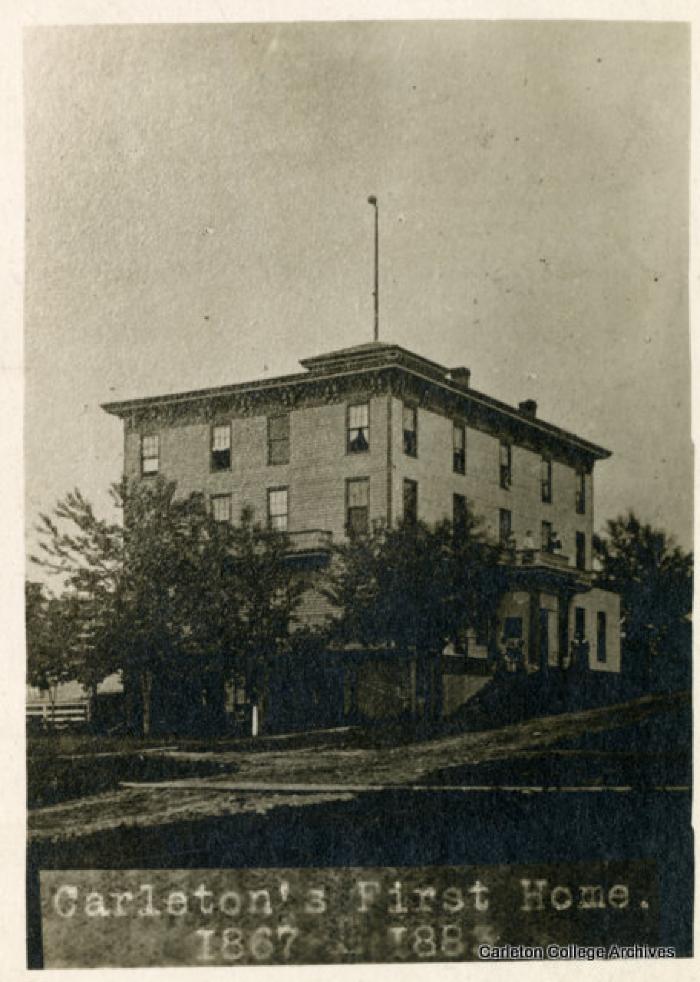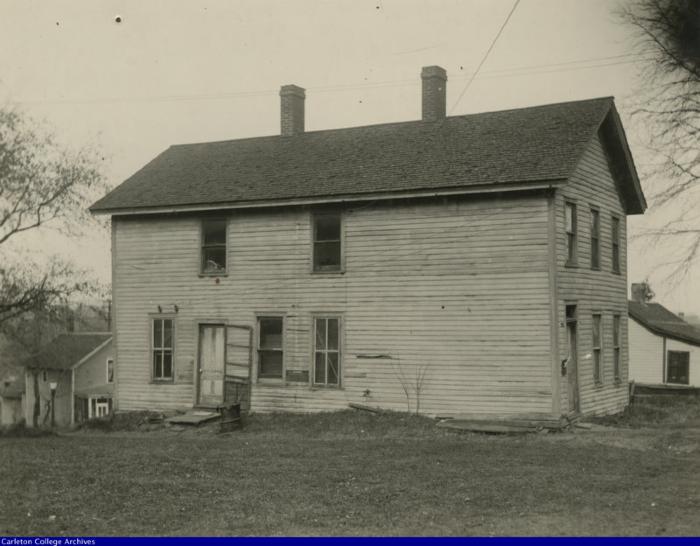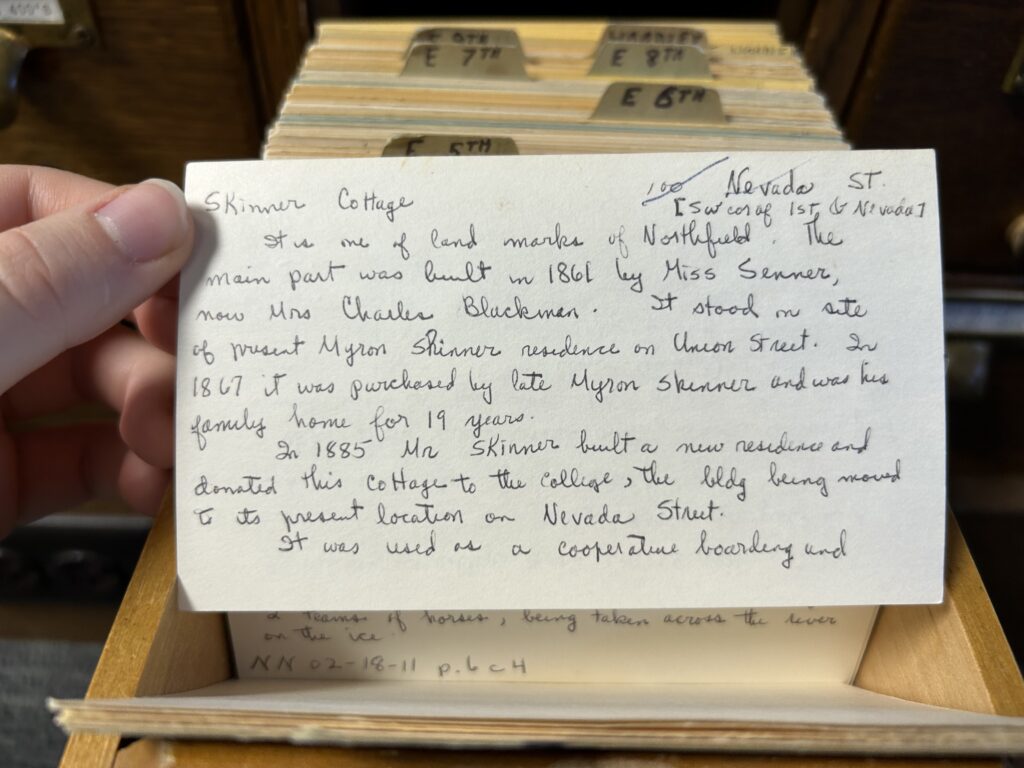Introduction
Throughout its long history, Carleton has seen many changes to its campus and the buildings in which students, faculty, and staff presided. This section within “Early Campus,” although titled after two of the oldest buildings to join Carleton College, will explore, through various structures, the ways in which the college and the city of Northfield began their relationship in the early decades of the college. Archival research at both the Carleton and Northfield archives revealed much about this topic. While American Hotel and Pancake Hall are two of the most interesting and earliest of these connections, they are by no means the only. Even today, many buildings of the college bridge the gap between our liberal arts institution and the residents of Northfield.
American Hotel
The American Hotel was the first actual building of Carleton, when it was still named Northfield College. The Hotel was originally built and owned by J.W. North in 1857 and housed at one time, 300 people, in 1859. Carleton bought the building in 1867 to house the college before Willis Hall construction was completed. Men were housed on the third floor and women on the second, with the first floor being used for recreation, chapel services, and recitation rooms and the basement for laboratory work, the library, and the dining hall. It remained a boarding house for students even after more dorms and academic buildings were built.

The Hotel was a center of life in Northfield, with travelers and businessmen staying there at various points of time, especially for those traveling to or from Hastings. At certain points in time, the hotel also housed a liquor saloon and a printing office. Northfield was chosen as the site of a higher education institution in 1866, and in the following year, the American Hotel was purchased for $5,500 and prepared for classes to begin the following year. Not only did students live and learn in the building, but the early board of trustees met there, and it was at those meetings that Rev. James W. Strong was appointed Carleton’s first president. It was additionally of much use when a fire burned down Willis Hall in 1970, and the main college functions did not transfer to Willis until 1872, at which point the American Hotel became a women’s dorm and was known as “Ladies’ Hall.”
Latin was the first subject taught at Carleton, then still Northfield College, in American Hotel with instruction in the Natural Sciences beginning in November and taught by Dr. Francis H. Atkins. It was in the second year of opening that Rev. Charles Seccombe was hired as a Senior Professor. That same year the library began at American Hotel, which would number 375 volumes before closing (presumably moved to another building). The first three books added to the library included: the Bible, Webster’s Dictionary (unabridged), and a five-dollar copy of Shakespeare’s complete works, the last of which was lost in a fire.
The archives of Carletonian articles reveal some of what daily life was like living and learning in American Hotel (or House, as it was officially named). Recounts describe the classes, taught by both men and women, and the students recitations in various subjects (references are made to History and Math, along with those previously mentioned). The experiences of a caller for the female residents is replayed, with much emphasis placed on the cold entryway in which they would at times be forced to wait for admittance. The perils of rats are recounted somewhat humorously, including the various objects used as projectiles before a trap was purchased, including: “1 volume of Hickok’s moral science…,” “1 ink stand…,” and “2 paper weights,” among others. An eating competition of griddle cakes is even mentioned, with the winner having consumed thirty cakes. One student, O. Howell, is said to have been so averse to spoons in the dining hall that he consumed oyster soup with a fork. But even beyond these recollections, one writer also speaks of the drive for knowledge that students shared, specifically the female students are are said to have known the true worth of their education, for example, “…one who has earned her year’s schooling by gleaning her father’s wheat fields knows something of what an education means.

After Willis Hall was constructed, the American Hotel became the Ladies’ Hall. However, in 1883 the ladies department of the college moved to the newly built Gridley Hall and the American Hotel fell into disuse. It help the occasional tenant or male student lodgers, but it was sold only a few years later to Mr. F. H. Lord (who had built the new observatory on campus) who tore the house down and built his own residence there. Some of the old house was repurposed for a barn, other parts were incorporated into the new residence, and the remaining pieces were disposed of.
Pancake Hall
Pancake Hall was a self-boarding building for male Carleton students. It was originally a store-front and was moved from its original location in 1869 to make way for a stone building that became the post office.The building opened for residents the fall of the same year, consisting of six, two-room suits. The name of the building comes in part from former resident, James J. Dow, who learned how to make “sour pancakes” during his childhood. The cheapness of ingredients made the pancakes a staple of the house. The hall was so named after a prank in which the boys in American Hotel across the way placed a signboard labeling the building “Pancake Hall” to the front of the building due to abundance of pancake eating that took place there. The building was torn down in 1930.

Pancake Hall is the building at 709 while American Hotel is is the building labeled “Old Ladies Hall.”
The building was one of the oldest in Northfield, having first served as a story owned by Hiram Scriver, one of Northfield’s early mayors and a trustee on Carleton’s board from the beginning. It was the first building to function only as a dormitory and was used by male students as a self-boarding option. One of Carleton’s first graduates, James Dow, resided in the building for some time during his time at Carleton (he also lived in Nourse Cottage when it was still the residence of the Nourses).

Dow describes how he learned how to cook pancakes during his childhood and thus became the designated cook of his roommates. His practice of making pancakes grew to other residents of the Hall due to the cheapness of the ingredients (essentially just water and flour). The results were not always great, and he described how one of his failed pancakes was tauntingly pinned to the building and left to harden in the harsh weather. At some point, the boys from American Hotel across the street, who Dow describes as their “friend-enem[ies],” created the sign naming the building “Pancake Hall” (Carletonian March 13, 1926). The prominence of pancakes was known through an old saying, that the boys of the hall ate pancakes “hot for breakfast, cold for lunch, and warmed over for supper,” although Dow refutes this idea (Carletonian March 13, 1926).

Life in Pancake Hall appears to be relatively rough, and the rivalry between those who resided in Pancake Hall and American Hotel appears to be strong. In one article, the boarders of Pancake Hall are described as “semi-starved.” In other recollections, there are tales of social gatherings that were held at Pancake Hall, and the boarders are seen as cheery and boisterous. There is no clear date as to when the hall ceased to be used as a dormitory. In one article, it is claimed that “Pancake Hall as gone to the rats,” which is dated to 1883. There is an article stating that the building had been sold in 1885. However, it seems unclear if there was anything done to the land or building. In 1927, termites are mentioned to have overrun the building and there is a reference in one article of the Northfield News requesting Carleton freshmen in 1928 to use Pancake Hall in their homecoming bonfire.

Other Residences in Northfield
Beyond American Hotel and Pancake Hall, there are various buildings like Seccombe House, that were originally built for Northfield residents but were later acquired by the college. The most similar to Seccombe is Nourse Cottage, which was a residence owned by the Nourse couple and located right were Nourse Hall is now. The couple allowed students to board with them at times, and they left it to the college in their wills. In honor of the couple, which had done much for students at the time, when the new ladies hall was being built, it was built upon the same location and named after them. We believe that Nourse Cottage was moved, much like Seccombe, but the location of the move is not completely known. The best that I could find in the archives was that it was moved to the “Huntington lot on E 2nd Street,” in Aug 1916 (the same year and roughly the same time Seccombe was moved) but there lacks clarification on if the building there is still the original Nourse Cottage.
There are several other buildings that Carleton owned at one point in time or another, some of which still exist and others which are long gone. Apart from the Chapel, at one point there was also a Skinner Cottage, which was donated to the college by the Myron Skinner. The building had been built in 1861 and bought by Skinner in 1967. The building was then moved (a common occurrence according to the archives!) to Nevada street in 1885 and donated the building to the college. The cottage was used as housing for female students for 18 years until a fire burned it down in 1910. The records after the fire give an example of how houses were moved during this time, as it is described that the house was put on wheels and drawn by two teams of horses. There are additionally records indicating that the Skinner sold land on 2nd Street to Carleton in 1901, the sale was for the two most northeastern blocks at the corner of 2nd and Division and it cost the college $3000. It is unknown if the Skinner’s house was changed after the sale, but in 1953 Ella Hendrickson moved into the location and there is still a Hendrickson house on campus.

Three other buildings that were built roughly within this time period and are still standing (somewhat) standing today are Strong house, Chaney house, and the Dacie Moses’ house. The latter, which is now undergoing significant renovations and is no longer quite ‘standing,’ was built in 1889 and later donated to the college in 1981, or thereabouts, to be used as student housing. Chaney house, which is the building of the culinary interest house, was built in 1891 by a Professor Chaney who taught at Carleton. It was purchased by Carleton roughly around 1926 as part of a campus expansion plan to provide home and board for unattached faculty members. Finally, Strong House was the residence of Carleton’s first president James W. Strong, and was built in 1900 and has since been renovated with the building now being used for administrative purposes.
The houses listed throughout this section are by no means the only buildings that existed on Carleton’s early campus. There were many records of houses changing hands between residents of Northfield and the college, and there is no doubt that some records have simply been lost to time. However, the houses described here give some indication into what life was like in the early decades of Carleton’s history and how the buildings on campus have a much deeper history than we recognize in our own use of them.
Bibliography
- “College Cullings.” The Carletonia. January 1, 1885. Accessed from Carleton Archives (https://apps.carleton.edu/digitalcollections/carletonian/).
- “Historical Addenda.” The Carletonia. February 1, 1887. Accessed from Carleton Archives (https://apps.carleton.edu/digitalcollections/carletonian/).
- “Heard on the Campus.” Northfield News. June 8, 1895. Accessed from Minnesota Archives (https://newspapers.mnhs.org/jsp/PsSearchResults.jsp).
- “Fire Fiend Busy.” Northfield News. October 1, 1910. Accessed from Minnesota Archives (https://newspapers.mnhs.org/jsp/PsSearchResults.jsp).
- “First Carleton College in Old American House, Town Hostelry, Says Grad of ’74.” The Carletonian. March 22, 1922. Accessed from Carleton Archives (https://apps.carleton.edu/digitalcollections/carletonian/).
- Dow, James J. “Legend of Pancake Hall Told by First Graduate.” The Carletonian. March 13, 1926. Accessed from Carleton Archives (https://apps.carleton.edu/digitalcollections/carletonian/).
- The Carletonian. November 12, 1927. Accessed from Carleton Archives (https://apps.carleton.edu/digitalcollections/carletonian/).
- “Held First Carleton Classes.” The Carletonian. February 2, 1940. Accessed from Carleton Archives (https://apps.carleton.edu/digitalcollections/carletonian/).
- Sanborn Insurance Maps from 1884-1920. Available in the Northfield Archives at the Northfield Historical Society.
- House File. Northfield Public Library. Records of building transfers and purchases from Northfield’s founding, often through archival research and newspapers. Open to the public.
- Various other articles from both The Carletonian and Northfield News provided context to the histories described here.